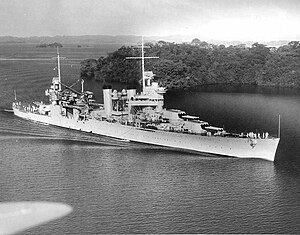 USS Vincennes, passing through the Panama Canal on 6 January 1938, while en route to join the U.S. Fleet in the Pacific
| |
| History | |
|---|---|
| Name | Vincennes |
| Namesake | City of Vincennes, Indiana |
| Ordered | 16 June 1933 |
| Awarded | 3 August 1933 |
| Builder | Bethlehem Shipbuilding Corporation's Fore River Shipyard, Quincy, Massachusetts |
| Cost | $11,720,000 (contract price) |
| Laid down | 2 January 1934 |
| Launched | 21 May 1936 |
| Sponsored by | Miss Harriet Virginia Kimmell |
| Commissioned | 24 February 1937 |
| Identification | Hull symbol: CA-44 |
| Honors and awards | |
| Fate | Sunk, Battle of Savo Island, 9 August 1942 |
| General characteristics (as built)[1] | |
| Class and type | New Orleans-class cruiser |
| Displacement |
|
| Length | |
| Beam | 61 ft 10 in (18.85 m) |
| Draft |
|
| Installed power |
|
| Propulsion |
|
| Speed | 32.7 kn (60.6 km/h; 37.6 mph) |
| Range | 10,000 nmi (19,000 km; 12,000 mi) at 15 knots (28 km/h; 17 mph) |
| Capacity | Fuel oil: 1,650 tons |
| Complement | 103 officers 763 enlisted |
| Armament |
|
| Armor |
|
| Aircraft carried | 4 × floatplanes |
| Aviation facilities | 2 × Amidship catapults |
| General characteristics (1942)[2][3] | |
| Armament |
|
USS Vincennes (CL/CA-44) was a United States Navy New Orleans-class cruiser, sunk at the Battle of Savo Island in 1942. She was the second ship to bear the name.
She was laid down on 2 January 1934 at Quincy, Massachusetts, by the Bethlehem Shipbuilding Company's Fore River plant, launched on 21 May 1936, sponsored by Miss Harriet Virginia Kimmell (daughter of Joseph Kimmell, mayor of Vincennes, Indiana), and commissioned on 24 February 1937, Captain Burton H. Green in command.[4]
The New Orleans-class cruisers were the last U.S. cruisers built to the specifications and standards of the Washington Naval Treaty of 1922. Such ships, with a limit of 10,000 tons standard displacement and 8-inch caliber main guns may be referred to as "treaty cruisers." Originally classified a light cruiser when she was authorized, because of her thin armor, Vincennes was reclassified a heavy cruiser, because of her 8-inch guns. The term "heavy cruiser" was not defined until the London Naval Treaty in 1930. This ship and Quincy were a slightly improved version of the New Orleans-class design.
- ^ "Ships' Data, U. S. Naval Vessels". US Naval Department. 1 July 1935. pp. 16–23. Retrieved 8 October 2015.
- ^ Rickard, J (19 December 2014). "Vincennes (CA-44)". Historyofwar.org. Retrieved 8 October 2015.
- ^ "US Cruisers List: Light/Heavy/Antiaircraft Cruisers, Part 1". Hazegray.org. 22 January 2000. Retrieved 8 October 2015.
- ^ "Vincennes II (CA-44)". Dictionary of American Naval Fighting Ships. Navy Department, Naval History and Heritage Command.